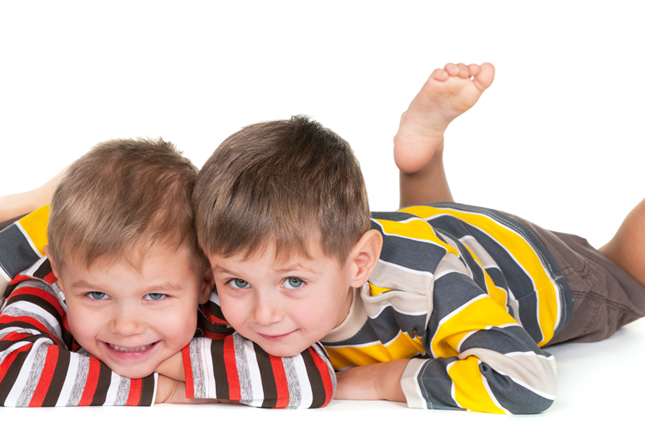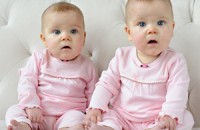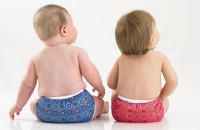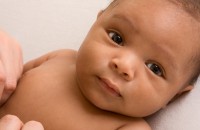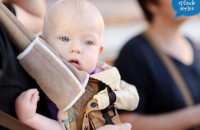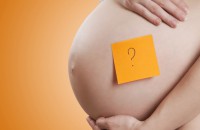Twin Talks
Chances of Twinning: Genetics and Fertility Treatments
[00:00:00]
Please be advised, this transcription was performed from a company independent of New Mommy Media, LLC. As such, translation was required which may alter the accuracy of the transcription.
[Theme Music]
DR. FRIEDMAN: Do twins run in your family? As a twin parent, you’ve probably been asked this question often. And if you know if your twins are fraternal or identical, you probably have a ready answer. But is it really true? Is there really a genetic connection? For those who used fertility treatments, this question may take on a completely different dimension for you. Whether or not you’ve used fertility treatments in the past, you may be wondering what are the chances of having another set of twins? I’m Dr. Brooke Friedman from San Diego Fertility Center. I’m here to talk about some of the myths of twinning. This is Twin Talks.
[Theme Music]
CHRISTINE STEWART-FITZGERALD: Welcome to Twin Talks. We are broadcasting from the Birth Education Center of San Diego. Twin Talks is your weekly online, on the go support groups for expecting and new parents of twins. I’m your host, Christine Stewart-Fitzgerald. Have you heard about the Twin Talks Club? Our members get bonus content after each new show plus special giveaways and discounts.
Subscribe to the monthly Twin Talks newsletter and learn about the latest episodes available. Another way for you to stay connected is by downloading our free Twin Talks app. It’s available in the Android, iTunes and the Windows Marketplace. Before we get started, I want to hand this over to Sunny who’s our producer.
SUNNY GAULT: Yes. I want to tell you guys a few ways that you guys can get involved with Twin Talks. We have a couple of fun segments on the show that you’ll probably enjoy. One is called Twin Oops and that’s where we share funny stories that we’ve experienced with our set of twins, triplets, multiples, fill in the blank. All the funny things that happen. If you’ve got a great story, we would love to hear it. We’d love to put it on our show.
You can ask our experts questions as well. As we’re continuing on with our today’s show, if you’d think of some good questions, send them in. We’ll have our experts answer them and we’ll put them on our future episodes. We have a segment where we talk about funny things that people have set us out in public with our twins. So that may be something you want to submit too.
There’s a whole section on the website that explores this and kind of gets into more details. If you go to www.newmommymedia.com and go over to Twin Talks, under the Shows Tab, you’ll see a section called Segments and then there you can see the various ways you can get involved.
If you do want to submit, there’s a couple of great ways to submit. You can go either—trough the website, you can go to the contact link. Or you can call our voicemail at 619-866-4775 and you can tell your story yourself, as opposed to us telling it for you.
CHRISTINE STEWART-FITZGERALD: Sunny, since you are a panelist today, tell us about your family.
SUNNY GAULT: My family—I have four kids total, and my oldest just turned five, a boy. I have another boy who’s three and does everything the five year old does. My twins—I have twin girls—that are almost two, 22 months to be exact. They’re identicals so supposedly everything is just happenstance. You know whoops, my egg split. No twins that I know of really in my family. Some stuff way back when but nothing that you would actually attribute to my pregnancy.
CHRISTINE STEWART-FITZGERALD: On the phone with us today, we have Natalie. Tell us a little bit about your family and your story. I think everyone really needs to hear this.
NATALIE DEVIGNE: I guess I’ll bring it back to my mom. My mom first had eight of us. Two sets of triplets and a set of twins. So take that and go to our next branch of the multiple side I guess. I’ll start with the eldest three of us which are all girls. My elder sister Cassy had a set of twins, identical girls. She has a singleton. Then down to me. I’m the middle.
My story is a little different. I have had eleven babies total now. I have three sets of twins. My eldest set of twins is going to be four and two months. My second sets of twins are identical girls and they are two and a half. My third sets of twins are identical boys and they are 17 months and two days which you want to get exact. I have a singleton who is going to be 10 months. Then I just recently had—and they are two weeks old—I had quadruplets. Three baby boys and one beautiful baby girl.
CHRISTINE STEWART-FITZGERALD: You have won the jackpot.
NATALIE DEVIGNE: So if you lost count, that is eleven all. And then finally we’re down out to the oldest of the triplets. That’s my sister Becca. She has had twin identical boys. They will be three and a half.
CHRISTINE STEWART-FITZGERALD: If I’m hearing this correctly then, your mother has—the two sets of triplets and they were, I’m assuming fraternal-
NATALIE DEVIGNE: Me and my sisters are fraternal. My mom had triplet boys and they are actually identical and they are all boys. Then my mom had a set of twins—boy, girl—fraternal.
SUNNY GAULT: Natalie, hopefully I’m not saying something you don’t want to be revealed and if I am, let me know. Your singleton baby girl that you just had was originally a triplet pregnancy, correct?
NATALIE DEVIGNE: It was originally a triplet pregnancy. It was her in one sac and the twins in another. I basically lost two of them. My singleton was a rainbow baby.
CHRISTINE STEWART-FITZGERALD: Yes, she survived her vanishing twins siblings.
NATALIE DEVIGNE: Yes, exactly.
CHRISTINE STEWART-FITZGERALD: So it sounds like you had a mix of both identical and fraternal.
NATALIE DEVIGNE: They’re not all fraternal now.
CHRISTINE STEWART-FITZGERALD: Have there been any fertility treatments involved in any of the births for either your mother, or your sisters or yourself? Or was it spontaneous?
NATALIE DEVIGNE: My mom did go through fertility treatments. She went through fertility treatments with the twins. She conceived the girls and the boy triplets naturally. My sister Cassy did do fertility treatments for her twins. But me and my sister Becca, conceived all of our multiples naturally.
CHRISTINE STEWART-FITZGERALD: Wow!! It’s just hard for us to get our heads around this.
SUNNY GAULT: I know. It is and it’s amazing.
[Theme Music]
CHRISTINE STEWART-FITZGERALD: I just want to take a moment and talk about a headline that just recently came out. The headline reads: Mother gives birth to three sets of twins at 500,000 to one odds. Here’s the story:
A couple from Scotland, 16 years ago, gave birth to twin boys. Two years later, they beat the odds again. They welcomed another set of boys. She’s a dance instructor. They had their hands full and they were very happy to have two sets of twin boys. Ten years go by and life settles down, the boys are teenagers.
She’s 41 years old and she gets a pregnancy scan and she finds out that she’s pregnant—yes, we know it—that she’s pregnant with twins. Thankfully it turned out, this third set was a set of girls. They were kind of balancing out a little bit. This is 500,000 to one so I have no idea what the odds are in your family.
SUNNY GAULT: No, lower than that.
DR. FRIEDMAN: The hard thing is that we’re taking something that’s uncommon to have, really among the people you’re talking to parents of twins. But in the general population, it’s uncommon to have fraternal twins, even more uncommon to have identical twins. So then among that population, the recurrence rate just hasn’t really been very wellstudied.
In general, like we’ve talked about we know there are certain risk factors, well identified genetic component to having fraternal twins. More so than having monozygotic or identical twins. But the specific recurrence rates aren’t that well defined. Just because you’re taking something rare and then among that rare event, you describe that 500,000 to one odds.It’s pretty uncommon.
CHRISTINE STEWART-FITZGERALD: You’re having lightning strike a couple of times.
SUNNY GAULT: And it will be that hard to find that many subjects if you’re doing a formal study.
DR. FRIEDMAN: And that’s the thing because the general rate of identical twins in the general population is about 0.5% so that’s less than 1%. Among that population, in terms of that happening again and again is a pretty rare event.
[Theme Music]
CHRISTINE STEWART-FITZGERALD: We’re here today with Dr. Brooke Friedman who is going to help us weave through these pregnancy myths that we hear about twinning in the headlines, in the social media. Dr. Friedman, she is a board certified reproductive endocrinologist and infertility specialist. She’s here to set the record straight. Thanks for joining us today Dr. Friedman.
DR. FRIEDMAN: My pleasure. Thank you for having me.
CHRISTINE STEWART-FITZGERALD: Maybe it’s good to take a step back and just talk about the statistics for fraternal and identical. What are the overall statistics for both unassisted or spontaneous as well as assisted infertility treatments?
DR. FRIEDMAN: Sure. Fraternals or non-identicals meaning twins that come from two different eggs. In the general population, spontaneously it’s really about 13 per 1000 depending on where you’re looking. It’s easier to think about as more like 2-3%, that’s going to vary depending on where you are in the world. There are geographic variations, ethnic variations. But in general it is about 2-3%. That’s spontaneous conceptions.
For identical twins, as I mentioned is only about 0.5%, so it’s really less than 1% of identical twins spontaneously.
Now if we’re talking about the world of infertility treatments, then those numbers change dramatically. Fraternal twins or non-identical twins—with fertility treatment, if someone’s taking a medication that causes them to release more than one egg then you’re going to dramatically be increasing the risk of a twin. It depends on what medication you’re taking and what treatment.
For someone taking something like Clomid, which is a common fertility drug, the rate of twins can be as high as 8-10%. You’ve already increased it quite a bit. With IVF—in vitro fertilization of two embryos are transferred then the rate of twinning can be as high as 30-50%. That’s pretty high. You are dramatically increasing the chance.
Obviously if you’re transferring a single embryo, then you’re decreasing your chance of twinning. It really depends on what fertility treatment. But certainly all across the spectrum of infertility treatment, whether more than one egg is released or one embryo is put back, you’re going to be increasing the chance of having more than one embryo implanted.
In terms of identical twins, in the world of IVF, the risk of identical twinning is increased, quite a bit as compared to spontaneous identical twins. So we said again at about 0.5%, with IVF some studies have shown it to be as high as anywhere between 1 and 10%. Pretty high. And it’s not really well understood. I’ll be honest. Some studies have suggested that may something to do with what happens in the lab, in terms of if there has been a manipulation to the shell around embryo.
Some studies have suggested that the longer that embryo remains in the lab in culture, meaning growing after fertilization to five days as opposed to three days, it may increase the chance of it splitting. Other studies haven’t found that to be true.
There was a very interesting study done just this year actually done where a clinic looked back over all their identical twins in the IVF. A lot of conventional things like time and culture after fertilization which we thought have been really well described, they didn’t see that to be as much of an association but when they went back into the family history like what we’re talking about, they found that those who had an embryo split actually did have a family history of twinning.
I think that conventional wisdom has told us that identical twins don’t have a genetic component but I think the more we learn thatthere very well may be a genetic component like we’re talking about with these studies which is not very well understood and is probably uncommon that for some people with identical twins clearly, there has to be a genetic component.
CHRISTINE STEWART-FITZGERALD: I think in Natalie’s family case, if you’ve got multiple sets of identical twins, some of them there were fertility treatments involved and others it was completely spontaneous. Natalie you shared that is was at different generations.
DR. FRIEDMAN: I think we’re learning a lot,
CHRISTINE STEWART-FITZGERALD: Going back to fraternal twins, you mentioned that the twinning rate can vary in different parts of the world. For those who are not as a result of fertility treatments and were purely just spontaneous, what are some of those factors that were behind it?
DR. FRIEDMAN: In terms of spontaneous twinning, a couple risk factors we talked about the genetic component. Women who are older aren’t like you’re eluded to having an increased risk of twins and that's really—because of what happens as we get older, some of the hormonal changes, our brain secretes more hormones specifically FSH or follicle stimulating hormone so more than one egg may be released at the same time in that month. That's a large part of why we think as women as we get older, it increase the risk of twins.
Also women who've had a previous pregnancy are at an increased risk of twins. Also women when they looked at cross-studies, were interestingly taller or have a BMI of over 30.
CHRISTINE STEWART-FITZGERALD: If you're tall or large—
NATALIE DEVIGNE: That means so much.
DR. FRIEDMAN: It's hard to know how that really—it’s back to genetics. Is it really because women are taller or is it that women who have a family history, are they all tall? No one really knows. We are just looking at cross studies. So those are things that have been fairly well described. Beyond that, those are the main factors.
CHRISTINE STEWART-FITZGERALD: When we talk about releasing two eggs at the same time, I think that's hyperovulation right? I've heard that this is passed down through generation. Can you tell us a little bit about how it's passed down?
DR. FRIEDMAN: Yes. You know what's interesting is the specific variations are not as well described but it does seem to be passed down through the mother. Meaning if I see a couple and the mother has twins, the husband has twins, it's really the mother's family history that matters to that couple's risk of having a twin. However, the father can pass that trait down to hisdaughter.
Meaning that then, his daughter may have an increased risk of twins if he has a twins in his family. But it's not necessarily. If a couple comes to me and the mother—the woman does not have a history in her family but the father does, it doesn’t appear from what we know that that individual couple would have a high risk of twins but their daughter may have an increased risk of twinning.
CHRISTINE STEWART-FITZGERALD: Then woman must have either a mother or a father that has the family history—
DR. FRIEDMAN: Exactly.
CHRISTINE STEWART-FITZGERALD: -with that genetic trait?
DR. FRIEDMAN:Correct. Yes.
CHRISTINE STEWART-FITZGERALD: So Natalie, I take it you said on your mother's side, she had identicals and fraternals. Did you mention on your father's side as well? There was a history of twinning for your husband?
NATALIE DEVIGNE: My husband's side, yes. My husband is a triplet. But his mom only had imminent brothers. So my mother-in-law would have had twins as well. Either herand her brothers andsisters, one of them would have been a set of twins. But it’s interesting to hear that it did start with my grandma, goes on to my mom and then goes on to me. Now so far, I’ve got five girls, all possibly carrying the multiple genes. It's interesting to hear one of my daughters may have 11 kids.
CHRISTINE STEWART-FITZGERALD: That's a good one.
SUNNY GAULT: Think of how many grandkids that means you're going to have.
DR. FRIEDMAN: It could be a large family.
CHRISTINE STEWART-FITZGERALD: So you had it going direct from generation. I heard there's this common myth of skipping a generation. Does that mean maybe it's going through the father's line?
DR. FRIEDMAN: I think that’s probably where that’s coming from because if in fact it would skip a generation, let's say a man’s mother had a history of twinning and then it would skip that and go to the—
CHRISTINE STEWART-FITZGERALD: his daughter
DR. FRIEDMAN: Correct. Exactly!
CHRISTINE STEWART-FITZGERALD: That would make sense. Switching over back to the identical side Doctor, you have talked about splitting in the lab. What about in just the natural spontaneous setting? Do we have any idea what's behind that?
DR. FRIEDMAN: No, we don’t know much. What's interesting is that we don’t see as much of the ethnic and geographic variations of identical twinning like we do withfraternaltwins. So I think we just know less about what the various factors are that contribute. It's also harder to study this rare event. But there aren't really well described risk factors for identical twinning apart from this potential family history.
CHRISTINE STEWART-FITZGERALD: I heard somewhere that there's a theory, just a theory right now. There's no real, true study or hard evidence. The theory is that the—I’ll just say chemicals for lack of my understanding—withinthe sperm itself cause the egg to split. Some sperm would contain some type of substance that might trigger a complete split rather than a divide.
DR. FRIEDMAN: Yes. I've heard that as well. I think there are some studies that have tried to look at this. It's just not been that well described and I should say that in general, the conventional wisdom is still that there is less of a genetic risk factor to identical twinning. It’s only been a handful of studies that have tried to look at this in the IVF population. But in general I think that conventional wisdom is really clear that there's a genetic component to fraternal twinning, less clear with identical twinning. But there certainly is this suggestion that there's a component of genetic risk factor as well.
CHRISTINE STEWART-FITZGERALD: Yes. I'm just saying, I have ID girls and a singleton, she's a girl as well. I'd like to blame it all on my husband. I basically told him that a) he's the one that chose the sex. I had nothing to do with that. You can't blame me.
DR. FRIEDMAN: That's true.
CHRISTINE STEWART-FITZGERALD: And for my ID girls as well, yes, I think its's your sperm that caused them to split. I had nothing to do with that.
DR. FRIEDMAN: It's possible.
SUNNY GAULT: I bought my husband a t-shirt for Christmas- last Christmas. It said: Real men make twins.Yes, I was like, it was like all you.
DR. FRIEDMAN: That’s great.
CHRISTINE STEWART-FITZGERALD: We’re going to take a break and when we come back, we’re going to talk about the myths of twinning and what families who use fertility treatments should consider.
Hey Twin Talks. Do you know you can listen to our episodes anytime, anywhere? Just download our apps available on iTunes, Amazon, and Google Play. It’s a great way to listen on the go. Like when you’re waiting for your perinatalogist, or perhaps your twin’s paediatrician. If you want to more great content about twins, be sure to join our Twin Talks Club. You’ll get extra bonus content, transcripts from the shows, discounts on great twin products, and more.
Be sure to visit us online at www.newmommymedia.com .
[Theme Music]
CHRISTINE STEWART-FITZGERALD: Welcome back. Today we are talking with Dr. Brooke Friedman about the myths of twinning. We touched on some possible causes of spontaneous twins. But what about twins resulting from the use of reproductive technologies? I think you touched on a little bit earlier about families who are using treatments. We do know the risk of twinning is much higher for fraternal twins and identicals. I think you mentioned a little bit about the process of handling in lab. Can you comment on both of them?
DR. FRIEDMAN: Sure. With regard to fertility treatments, any time a woman takes a medication that’s going to encourage her ovaries to release more than one egg, then she’s going to be increasing her risk of having twins. With regard to IVF, it does seem that there’s an increased likelihood of an embryo splitting after it’s implanted into the uterus. Meaning in the lab, the embryo doesn’t split. But after we put it back in to the uterus, if that embryo has been treated as part of the IVF cycle, there is an increased risk of that embryo splitting as compared to what we see in the general population of the risk of an embryo splitting in the uterus.
I think we don’t really know exactly why. Different theories have been proposed with regard to what happens in the lab. But the truth of it is it’s a little bit unclear exactly why these embryos have an increased risk of splitting after they are transferred back to the uterus.
I think it’s certainly something that each woman, each couple should talk to their doctor about it if they are undergoing infertility treatments with regard to how their doctor would counsel them individually with regard to their risk of twins. Each woman’s risk is different based upon how their ovaries respond, based upon her age based upon her family history like we talked about. I think it’s certainly really important to get that individualized counselling. So for women to really ask their doctor: “what do you think is my risk of twins are?” to really have an understanding of what their risks are with each treatment so that everyone’s on the same page.
CHRISTINE STEWART-FITZGERALD: I’ve heard that, let’s just say that the philosophy can vary from practice to practice when it comes to fertility treatments. Aside from yes, you can transfer multiple embryos, are there any other factors in terms of just the standard operating procedures and practices that that family is considering fertility treatments should ask their doctor? Like, how do you approach this? What should they be asking their doctors when asking a consultation?
DR. FRIEDMAN: Absolutely. I think you hit on a really important one and that is asking their fertility doctor: what is your practice and what would you recommend with regard to single versus double embryo transfers. Again, that decision is usually individualized based from patient’s age, embryo quality and a lot of things go into that decision. But certainly, it’s really important to have that discussion with someone’s individual physician.
When women take fertility medications like Clomid or sometimes inject-able medications to cause the ovaries to make eggs, normally they’re monitored. Meaning we do ultrasounds to see how many eggs are growing this month. I think in that situation, it’s important for the woman to ask her doctor how many eggs—how many follicles rather do you see growing?
A follicle is that “cul de sac” where eggs develop. And to say “what are my risk of twin do you think this month?” like what we talked about. That is going to vary depending on age, depending on someone’s history and their family history so I think those are all questions that are important to ask, because each month may be different.
Certain physicians, if they see too many follicles growing, they’re going to recommend cancelling the cycle. For example, if I see someone who hasrecruited too many eggs in a given month, I’m going to say the risk of twins or higher order multiples is too high, and I recommend cancelling and not doing an in treat or aninsemination and not trying at home this month because it can vary month to month. So it’s really important to do that monitoring, with ultrasound to be able to help prevent at least iatrogenic, higher order multiples or iatrogenic twins if possible.
CHRISTINE STEWART-FITZGERALD: It sounds like you’re taking a more conservative approach and there might be other endocrinologists in infertility who may be more liberal I guess in terms of harvesting or implanting.
DR. FRIEDMAN: You know I think there’s going to be variations in practice patterns. So certainly I think it’s important to stick to individualized counseling for each patient. Every patient’s risk is going to be different. I think certainly it’s important to have that conversation with their physician. I think we do know that twins do carry a higher risk of complications potentially so certainly I think it would make the most sense to try to minimize that risk if possible.
CHRISTINE STEWART-FITZGERALD: Yes. I’m just curious. I know that Sunny here and I, we have identical twins. When I found out that they were identical, I felt like: wait a minute, this is good. This means I’m not hyper ovulating and so my risks aren’t changing. It’s okay to have more kids? But I don’t know. Is there really any difference as for—I mean for those who are having identical versus fraternal spontaneously?
DR. FRIEDMAN: I think it’s a great question. I think the answer is, we don’t really know. It’s clear that for someone who’s had fraternal twins, there’s more of a genetic component. There’s probably going to be an increased risk of having another set of fraternal twins.
With regard to splitting like you mentioned, that’s 500,000 to one odds of this woman who had multiple sets of twins. I think that there very well may be some increased risk but it just really hasn’t been that well described in terms of having to quantify that increased risk. So I think you’re safe.
SUNNY GAULT: We’re safe. For now, we’re safe.
DR. FRIEDMAN: Until more research comes out.
CHRISTINE STEWART-FITZGERALD: Exactly. Thanks so much everyone for joining us today. Be sure to visit our episode page on our website for more information about Dr. Friedman as well as links to additional resources. This conversation continues for members of the Twin Talks Club. After the show, Dr. Friedman will address some myths about spontaneous twinning. For more information about the Twin Talks Club, visit our website at www.newmommymedia.com.
[Theme Music]
SUNNY GAULT: It’s time for one of our favorite segments on the show. It’s called “We are Expecting What?” That’s where you guys get a chance to tell us about your funny stories of when you found out you were pregnant with twins.
This story comes from Krista. Krista says:
“I am 18 and a mother-to-be of two baby girls. We found out I was pregnant at six weeks and we were excited. I talked with my sister-in-law because she was pregnant with her third. She referred me to her doctor. My brother joked saying I’m going to have two. After going to the doctor couple of times, he told me I was bigger that he thinks I should be.
He says, “Do you think there’s twins?’ Me and my boyfriend laughed. He then scheduled an ultrasound to check for twins. We were in shock. We couldn’t wait for two weeks to find out. The ultrasound showed two babies and I’ll never forget the feeling I got when I saw them both. My heart melted. I was excited and scared at the same time. I’m now 21 weeks and very used to the thought of twins.
I’m very excited but I’m also very nervous about having them early and their health—what kind of health and they’re going to be in--all the things that could go wrong. All I could do is hope and pray that they are healthy.”
Well Krista, we certainly hope that you have a fantastic rest of your pregnancy. You are about clearly more than a half way there. Hopefully, things are really still going well for you. And we’ll just kind of keep you in our thoughts and thanks for writing this in.
CHRISTINE STEWART-FITZGERALD: That wraps up our show for today. We appreciate you listening to Twin Talks.
Don’t forget to check out our sister show:
• Preggie Pals for expecting parents
• The Boob Group for moms who breastfeed their babies
• Parent Savers yourparenting resource on the go
• Newbies for new parents
This is Twin Talks, parenting times two.
[Disclaimer]
This has been a New Mommy Media production. The information and material contained in this episode are presented for educational purposes only. Statements and opinions expressed in this episode are not necessarily those of New Mommy Media and should not be considered facts. While such information and materials are believed to be accurate, it is not intended to replace or substitute for professional, medical advice or care and should not be used for diagnosing or treating health care problem or disease or prescribing any medications. If you have questions or concerns regarding your physical or mental health or the health of your baby, please seek assistance from a qualified health care provider.
SUNNY GAULT: New Mommy Media is expanding our line-up of shows for new and expecting parents. If you have an idea for a new series, or if you’re a business, or an organization interested in joining our network of shows through a co-branded podcast, visit www.NewMommyMedia.com.
[00:30:37]
[End of Audio]
